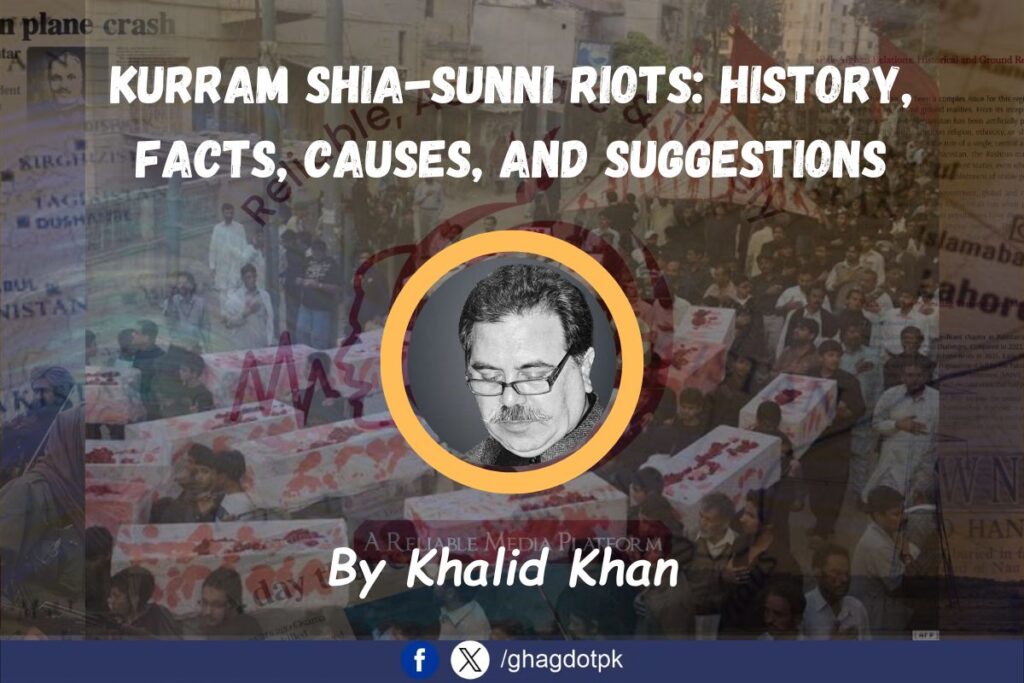By Khalid Khan
The Pakistani people in general and Pashtuns in particular are among those unfortunate nations who have always fought others’ wars. Pashtuns are easily used as fuel in conflicts ignited by outsiders. At times, they pour the oil of religion on themselves, at times they dive into the acid of nationalism and ethnicity, and at times they set themselves, their homeland, country and their nation on fire for wages. The wars of the Arab lands have always been fought by Pashtuns on their own soil, but despite countless losses, no lesson has yet been learned. Leaving aside religious wars, Pashtuns have repeatedly become fodder in Central Asia’s global imperial economic battles under various pretexts. The vast and picturesque valley of Kurram has also been reduced to ashes by the fire of Shia-Sunni conflict, and recent violent incidents foretell further destruction. For a long time, the overall situation in Kurram has remained extremely concerning, rooted in historical backgrounds and several ground realities.
In 1938, the sectarian riots that began in the undivided Indian city of Lucknow laid the foundation of sectarianism in Kurram as well. During the Lucknow riots, the Turi tribes of Kurram wanted to go to India to assist the Shia community, but local Sunni tribes stood in their way. This prepared the ground to fight Lucknow’s battle in Kurram, and since then, the people of Kurram have never found peace. Every ten to fifteen years, the towns of Sadda or Parachinar become the center of sectarian conflicts. After the 1938 Lucknow riots, a bloody and fiery wave erupted in Sadda in 1966 due to a mourning procession. A third upheaval occurred in 1970 over the construction of a minaret at the Jamia Masjid in Parachinar, while in 1977, riots broke out following an attempt to assassinate the muezzin of the Jamia Masjid in Parachinar.
In 1982, bloodshed occurred in Sadda when a Shia elder was accused of allegedly making blasphemous remarks. In 1996, riots broke out following the killing of Sunni students at Parachinar High School. In April 2007, an incident of stone-pelting on a Rabi-ul-Awwal procession led to bloodshed, while in November 2007, sectarian violence erupted over an alleged murder, and the situation has remained tense ever since.
The 2007 riots were exceptionally severe, where several teachers on duty in an examination hall were killed, and their bodies were burned. Vehicles were stopped, and passengers were shot. These riots also saw incidents of looting and burning of property, forcing a large number of people to migrate, many of whom have yet to return to their homes.
As a result of these sectarian riots, the main road remained closed to traffic for a long time, reopening for regular use in 2012. The responsibility for Kurram’s sectarian tensions lies with the state, as all relevant institutions completely failed to perform their duties, leaving the state paralyzed throughout this period. Before Kurram’s merger with the settled districts, the political administration had used extensive resources and traditional jirgas to establish peace between the parties, leading to significant decisions. The Kohat and Murree agreements hold particular importance among these decisions. However, state institutions failed to benefit from these peace agreements.
Another failure of the state that added fuel to the sectarian fire is its ongoing inability to manage the official distribution of properties in Kurram. Jointly owned lands are often the cause of private disputes, which are given a sectarian color for personal gains. Unfortunately, these jointly owned lands are located between Shia and Sunni villages, continuously causing unrest and being framed as religious and sectarian issues.
Due to the absence and lack of interest of state institutions, locals take their private matters to religious leaders, where their nature completely changes. Before the rise of religious extremism, such issues were taken to local elders, commonly known as Maliks, who resolved them based on Pashtun traditions, ensuring that peace in Kurram was never threatened.
The dominance of religious leaders has fueled disputes over properties, turning economic issues into religious ones, which sectarian leaders exploit for their personal gains. To address land-related issues, sectarian organizations have been established under the names of Anjuman Hussainia and Aqwam Ahl-e-Sunnat. Until 2007, the leadership of Aqwam Ahl-e-Sunnat was held by Anjuman Farooqia in Parachinar, but following the migration of Sunnis from Parachinar, this organization practically disappeared. Although this group claims to guide displaced people from Parachinar, its performance has never been positive or noteworthy.
After the Afghan Jihad, Afghan Mujahideen leaders sold large quantities of modern and deadly weapons to local organizations and the general population of Kurram. This not only transferred heavy weapons to the area but also fueled a warlike mindset among the local population, enabling both sides to acquire combat skills. The situation in Parachinar was also deeply influenced by the Iranian revolution, as all main roads in the city were adorned with life-sized posters of Iranian leaders. Before the revolution, such Iranian influence on the local Shia population was never observed.
Many youths from Kurram participated in the Syrian conflict for large sums of money. After fighting in Syria and Iraq, these fighters have now returned to Kurram. Is this not a challenge for the state? Wherever Shia-Sunni tensions arise in the world, sectarian flames are reignited in Parachinar. Foreign aid meant for orphans and widows is spent on sectarian fights.
Following Kurram’s merger with Khyber Pakhtunkhwa, the collective responsibility law under the FCR has been abolished, leading to an increase in crime, with target killings on the main road becoming a daily occurrence. Disputes over jointly owned lands often lead to sectarian violence, as evident in recent violent incidents where property disputes turned into acts of terrorism.
In recent years, deadly incidents involving the Mangals of Gido and the Ali Zai tribes of Pewar were rooted in property disputes. The Mangals of Gido have suffered more because they rely solely on the main road, which passes through Pewar, exposing them to frequent attacks during travel.
Another misfortune is the irresponsible use of social media by both sides, where individuals residing abroad play a highly negative role, further deepening divisions and fueling bloodshed.
The solution to these problems lies solely with the state. It must sincerely implement past peace agreements, establish its authority in the region, remain impartial and fair, and shift authority from religious leaders to national leaders.
Whenever the state of Pakistan fully enforces its foundational law, peace will be established. The Khyber Pakhtunkhwa government, led by Pakistan Tehreek-e-Insaf, should refrain from fighting internal battles based on external conflicts and stop selecting between good and bad terrorists. The provincial government must wake up from its slumber, fulfill its responsibilities regarding Kurram, or risk irreparable damage and a point of no return.






